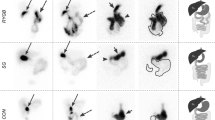Abstract
To delineate relationships between biliary outputs of bile acids, phospholipids, and cholesterol, studies were carried out in 18 subjects with intact gallbladders and in six with cholecystectomy. Hepatic secretions of three biliary lipids were determined using an intestinal perfusion technique. In studies on subjects with normal gallbladders (study A), continuous infusion of liquid formula was given to stimulate gallbladder contraction, so that gallbladder storage was eliminated and duodenal outputs were equal to hepatic secretion rates. Bile acid pool size and bile lipid outputs were determined under steady-state conditions (intact EHC). Secretion rates of bile acids were then reduced by progressively withdrawing large amounts of bile from the EHC over a 12-hr period, during which biliary lipid secretions were measured continuously. In study B, six subjects without gallbladders ingested three meals of liquid formula during the day and had an overnight fast. Measurements of biliary lipid outputs were made hourly over the 24-hr period. A wide range of bile acid secretion rates occurred under these physiological conditions owing to the lowering of bile acid outputs during fasting. In both studies A and B, bile saturation with cholesterol increased as EHC became interrupted. However, the magnitude of this increase was variable from subject to subject and appeared to depend on two related factors. First, bile saturation was markedly increased in subjects who exhibited a severe reduction of bile acid output on interrupting the EHC. Second, the degree of uncoupling of cholesterol and phospholipid secretion in the lower range of bile acid outputs was also variable. When secretion of cholesterol was well-maintained in the face of decreasing bile acid and phospholipid outputs, bile became supersaturated. Subjects with high biliary cholesterol during intact EHC were especially prone to cholesterol-phospholipid dissociation. However, even at relatively low outputs of cholesterol, interruption of the EHC sometimes caused marked dissociation of secretions of cholesterol and phospholipids causing super-saturated bile at low rates of bile acid flux. Thus, the degree of coupling of cholesterol and phospholipids at low secretion of bile acids was variable from patient to patient and was a major determinant of the extent of increase in bile saturation.
Similar content being viewed by others
References
Wheeler HO, King KK: BIliary excretion of lecithin and cholesterol in the dog. J Clin Invest 51:1337–1350, 1972
Hardison WG, Apter JT: Micellar theory of biliary cholesterol excretion. Am J Physiol 222:61–67, 1972
Dowling RH, Mack E, Small DM: Biliary lipid secretion and bile composition after acute and chronic interruption of the enterohepatic circulation in the Rhesus monkey IV primate biliary physiology. J Clin Invest 50:1917–1926, 1971
Thureborn E: Human hepatic bile composition changes due to alter enterohepatic circulation. Acta Clir Scand (Suppl) 303:63, 1962
Nilsson S, Schersten T: Importance of bile acids for phospholipid secretion into human hepatic bile. Gastroenterology 57:525–532, 1962
Grundy SM, Metzger AL, Adler RD: Mechanisms of lith-ogenic bile formation in American Indian women with cholesterol gallstones. J Clin Invest 51:3026–3043, 1972
Northfield TC, Hofmann AF: Biliary lipid secretion in gall-stone patients. Lancet 1:747–748, 1973
Northfield TC, Hofmann AF: Biliary lipid output during three meals and an overnight fast. I. Relationship to bile acid pool size and cholesterol saturation of bile in gallstone and control subjects. Gut 16:1–17, 1975
Wagner, CI, Trotman BW, Soloway RD: Kinetic analysis of biliary lipid excretion in man and dog. J Clin Invest 57:473–477, 1976
Grundy SM, Metzger AL: A physiological method of estimation of hepatic secretion of biliary lipids in man. Gastroen-terology 62:1200–1217, 1972
Grundy SM: Effects of polyunsaturated fats on lipid metabolism in patients with hypertriglyceridemia. J Clin Invest 55:269–282, 1975
Bennion LJ, Grundy SM: Effects of obesity and caloric intake on biliary lipid metabolism in man. J Clin Invest 56:996–1011, 1975
Metzger AL, Heynsfield S, Grundy SM: The lithogenic index—a numerical expression for the relative lithogenicity of bile. Gastroenterology 62:499–501, 1972
Thomas PJ, Hofmann AF: A simple calculation of the lith-ogenic index of bile. Gastroenterology 65:698–700, 1973
Hegardt FG, Dam H: The solubility of cholesterol in aqueous solutions of bile salts and lecithin. Z Ernaehrungswiss 10:223–233, 1971
Holzbach RT, Marsh M, Olszewski M, Holan K: Evidence that supersaturated bile is frequent in healthy man. J Clin Invest 52:1467–1479, 1973
Lindblad L, Lundholm K, Schersten T: Influence of cholic and chenodeoxycholic acid on biliary cholesterol secretion in man, Eur J Clin Invest 7:383–388, 1977
Nilsson S: Synthesis and secretion of biliary phospholipids in man. Acta Chir Scand (Suppl) 405, 1970
Balint JA, Beeler DA, Kyriakides EC, Treble DH: The effect of bile salts upon lecithin synthesis. J Lab Clin Med 77:122–133, 1971
Robins SJ, Armstrong MJ: BIliary lecithin secretion. II. Effects of dietary choline and biliary lecithin synthesis. Gastroenterology 70:397–402, 1976
Edwards PA, Muroya H, Gould RG:In vivo demonstration of the circadian rhythm of cholesterol biosynthesis in the liver and intestine of the rat. J Lipid Res 13:396–401, 1972
Dietschy JM, Brown MS: Effects of alterations of the specific activity of the intracellular acetyle CoA pool on apparent rates of hepatic cholesterogenesis. J Lipid Res 15:508–516, 1974
Ho KJ, Drummond JD: Circadian rhythm of biliary excretion and its control mechanisms. Am J Physiol 229:1427–1437, 1975
Vlahcevic ZR, Bell CC, Gregory DH, Buker G, Juttijudata P, Swell L: Relationship of bile acid pool size to the formation of lithogenic bile in female Indians of the Southwest. Gastroenterology 62:73–83, 1972
Author information
Authors and Affiliations
Additional information
This project was supported by the Medical Research Service of the Veterans Administration and by NIH Research Grants HL-14197, awarded by National Heart, Lung, and Blood Institute, and AM-16667 from the National Institute of Arthritis, Metabolism, and Digestive Diseases PHS/DHEW.
Rights and permissions
About this article
Cite this article
Mok, H.Y.I., Von Bergmann, K. & Grundy, S.M. Effects of interruption of enterohepatic circulation on biliary lipid secretion in man. Digest Dis Sci 23, 1067–1075 (1978). https://doi.org/10.1007/BF01072880
Issue Date:
DOI: https://doi.org/10.1007/BF01072880




